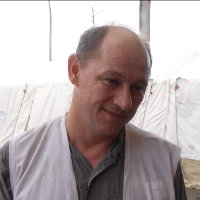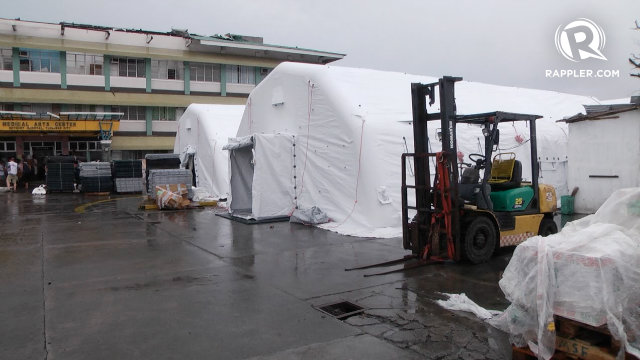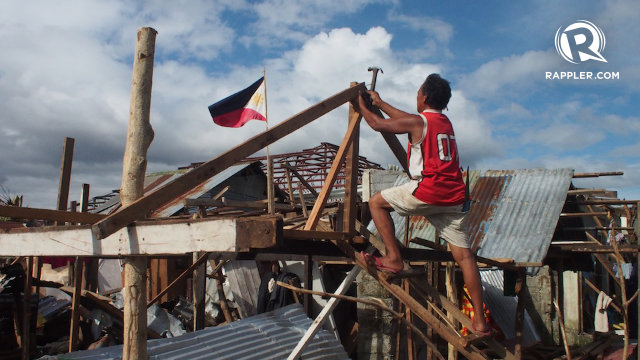SUMMARY
This is AI generated summarization, which may have errors. For context, always refer to the full article.
 Too many journalists are asking us to compare Typhoon Yolanda (as it’s known locally) and the 2010 earthquake in Haiti. Many of us here were in Port-au-Prince in 2010 and we all agree: the two disasters have nothing in common, and any comparison would be indecent.
Too many journalists are asking us to compare Typhoon Yolanda (as it’s known locally) and the 2010 earthquake in Haiti. Many of us here were in Port-au-Prince in 2010 and we all agree: the two disasters have nothing in common, and any comparison would be indecent.
Already, before June 12, 2010, Haiti faced many disadvantages: poor public services, political instability, urban crime and widespread poverty. The earthquake hit a state that was already in the midst of a humanitarian crisis. MSF (Doctors Without Borders or Médecins Sans Frontières) teams had been working on the ground for years and were able to start operating straight away.
Before Nov 8, 2013, the Visayan archipelago was a touristy destination, popular with divers, backpackers, eco-friendly tourists, honeymooners and sexual predators (though I wish we didn’t have to mention those). The Filipino state emergency response agencies worked almost full-time for years, moving from typhoon to earthquake to volcanic eruption. While it took MSF almost a week to get there, the agencies’ response mechanisms were set in motion instantly.
Going back to normal
Many survivors say they hadn’t anticipated the sudden increase in water level because English-speaking media spoke about a “storm surge” and never used the term “tsunami.” I also didn’t immediately understand what this “storm surge” referred to. As a result, the most educated people evacuated the area, whereas others thought they would just be facing violent storms, something they are used to.
A terrible rumor illustrates how the Filipinos learned the hard way what the term “storm surge” meant. Being long familiar with typhoons, the government is said to have deployed 200 policemen on the ground in order to reestablish order as soon as possible and to limit looting.
As a result, 200 policemen drowned. I wasn’t able to verify the information, but I have seen images of floating bodies wearing T-shirts with the legend “PULIS.” If you want to sound the alarm and save lives, make sure you’re going to be understood. When people hear “tsunami,” they start running. When they hear “storm surge,” at best they look for a dictionary. Which is what I did.
The priority for survivors is to get back to normal life – or at least to be self-sufficient again. The majority of the most vulnerable people were able to leave the devastated area thanks to mass evacuations coordinated by the army. Conversely, thousands of Filipinos came spontaneously from all over the archipelago and from overseas in order to help their families, their friends and their fellow citizens. More than 30,000 Filipino aid workers are involved in the ongoing response.
Two weeks on, the drowned of Tacloban have almost all been buried. Streets are usable and busy. People visit food distribution centers as if they were on a shopping trip, selecting only what they need. The water system is functioning again – whereas it still doesn’t in Port-au-Prince, where cholera still has devastating effects. Shops have re-opened. ATMs spit out cash. Prostitution is back.
In the meantime, more than two weeks after the tsunami/storm surge, hundreds of NGOs keep meeting every night at 6 pm in their crisis center in order to decide who is going to do what, under the half-amused, half-sleepy eye of a government representative. This morning, while an NGO was trying to draw attention to its distribution, Tacloban’s inhabitants were passionately watching their national hero Manny Pacquiáo’s boxing game on the big screens installed in the streets.

Health risks persist
But stay cautious. Even though the risks of measles, polio, cholera epidemics and malnutrition – much talked about during the 6 pm meetings – are likely to be minimal, the devastation has created new health hazards that MSF is doing its best to warn against in the midst of all the noise.
When the first MSF team arrived in Tacloban six days after the tsunami/storm surge, we were sleeping on the floor of a garage. I remember being pleasantly surprised by the absence of mosquitoes during this Spartan night. The mosquitoes who couldn’t be evacuated by the government were probably wandering around somewhere between India and Saudi Arabia.
The anopheles mosquito needs only a couple days to reproduce, providing the water is not salty. The tsunami/storm surge left behind brackish floods, impractical for breeding mosquitoes, however horny. But it has rained every day since, and the pH of the ponds is now suitable for “insect-making” intercourse. Mosquitoes are thus back en masse and abstinence has made them hungry and angry.
The risks of dengue fever, chikungunya and malaria are serious for all those living in the open, or in houses with smashed windows. Filipino people need to be able to protect themselves with prophylactic treatments, sprays and mosquito nets. Yet today, tens of thousands of blankets are being distributed throughout the archipelago by various organisations of every flavor. Why? Because… winter is coming?
Along the same line, rats are everywhere and represent a health hazard as carriers of infectious diseases such as leptospirosis. But Filipinos are well aware of this risk and know how to protect themselves without condescending lectures on hygiene.
Signs of normalcy
Humanitarian emergency relief response to disasters is above all else the science of improvisation. Never mind the obvious oxymoron (which is to contradiction what “storm surge” is to “tsunami”), improvisation requires preparation. People expect a large international humanitarian machine to be set in motion. They do not expect, however, that this machine will not be able to adjust to the situation and will hold back when it becomes obvious that supply will exceed demand.
In the end, our biggest fear is road accidents, given the potential severity of the injuries and the few hospitals equipped to handle them. A lot of vehicles were lost in the tsunami/storm surge, and the rare means of transport today are monopolised by NGOs. Having five people on a single motorbike without wearing helmets drastically increases the risk of serious accidents, particularly when riding on wet, slippery roads.
Since the major roads were cleared, sparkling new air-conditioned four-wheel-drives seem to be recreating an episode of the series ER by driving down them at full speed – an incredibly dangerous game given the number of people currently camping on the verges. A team of cops equipped with cameras and speeding tickets would probably save more lives than these road hogs.
Another hazard is the risk of fires and serious domestic burns. Left without electricity, people use candlelight and cook on small gas stoves or braziers on the ground. The wet season is not only a blessing for hungry mosquitoes, it also stops fires spreading. Conversely, the catastrophe in Haiti took place at the beginning of the dry season, when the sun stuns the whole of the Caribbean islands. More than three years afterwards, caring and nursing for badly burnt people is still one of the main activities of MSF in Port-au-Prince.
For the first few days after the disaster, night-time silence entirely filled the sleeping city. No more electricity. No more cars. People were exhausted. For months in Haiti, the sound of silence was troubled by shouts, cries, chilling screams, gunshots. Yesterday night in Tacloban, from the fifth floor of our MSF hotel overlooking the city, I could hear a couple making love.
‘Taking back the city’
Clearing yet another office on the ground floor of what used to be the administration building of Bethany Hospital, I stumble across a box of pills to treat erectile disorder, which of course I give to the medical coordinator in case someone really needs it. It’s actually an option in the treatment of temporary depression, common after such a tragic event. From now on, whenever I hear frisky lovemaking through the Filipino night, I won’t help but think about my modest contribution to this prompt return to normality, for which Filipinos should be congratulated.
The impressive speed at which the people of Tacloban are taking back ownership of their city could limit our response to a short period, perhaps a few weeks. MSF has approximately 30 international staff in Tacloban, but this number should decrease rapidly. The hospital has now been set up and Filipino medical staff are coming back en masse to resume their work.
One of the hospital doctors came to visit me two hours after I had finally managed to set up my “office.” I was covered in sweat and all of my muscles ached. “I am the director of this hospital and you are in my office,” he said, with a stern look on his face.
Ouch. I have a feeling I am going to be clearing myself another space very soon. If I find another box of the blue pills, this time I’ll leave them there so as not to anger their owner.
Beyond physical space, medical cohabitation between a humanitarian organization and a private hospital can very quickly become complicated. Skillswise, Bethany hospital’s former staff will soon be able to provide all the care needed. However, in terms of free care, at least for the poorest, MSF is going to need some guarantees before we leave. Our patients don’t pay anything. It’s a non-negotiable aspect of MSF’s work.
One last symbol: the first programmed surgery in the hospital was not the amputation of an infected limb but a caesarean section. Yolanda if it’s a girl, Haiyan (or storm surge) if it’s a boy? – Rappler.com
Yann Libessart is the media relations head for the Médecins Sans Frontières (Doctors Without Borders) team in Tacloban City, Leyte. This article was originally posted on the MSF in the Philippines blog. We’re republishing it with Libessart’s permission.
Add a comment
How does this make you feel?

There are no comments yet. Add your comment to start the conversation.